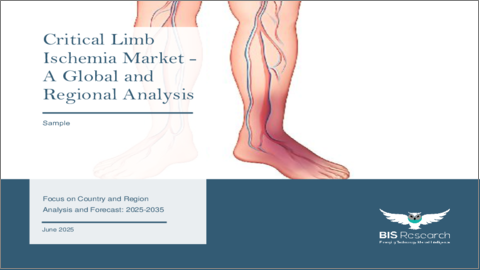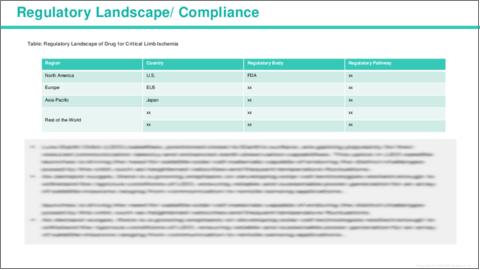|
|
市場調査レポート
商品コード
1759276
重症下肢虚血市場- 世界および地域別 - 分析と予測(2025年~2035年)Critical Limb Ischemia Market - A Global and Regional Analysis: Focus on Country and Region - Analysis and Forecast, 2025-2035 |
||||||
カスタマイズ可能
|
|||||||
| 重症下肢虚血市場- 世界および地域別 - 分析と予測(2025年~2035年) |
|
出版日: 2025年06月30日
発行: BIS Research
ページ情報: 英文 100 Pages
納期: 1~5営業日
|
全表示
- 概要
- 図表
- 目次
重症下肢虚血は、末梢動脈疾患(PAD)の重症で進行した段階であり、四肢(典型的には足や脚)への血流が著しく減少する状態です。
重症下肢虚血は、動脈が著しく狭窄または閉塞した場合に発生し、通常は動脈硬化が原因で、脂肪沈着物やプラークが動脈に蓄積し、血流が制限されます。この血液循環の低下により、組織から酸素と必須栄養素が奪われ、激しい痛み、治癒しない潰瘍、壊疽を引き起こし、場合によっては切断が必要となります。
重症下肢虚血は、死亡率および身体障害のリスクが高く、慢性的な安静時痛、治癒しない創傷、または患肢の組織死を経験した人に典型的に診断されます。この疾患は、糖尿病、高血圧、喫煙、肥満などの危険因子を有する人に最もよくみられます。治療には通常、内科的管理、(血管形成術やステント留置術のような)低侵襲的処置、外科的介入、そして場合によっては血流を改善し患肢を温存するための再生療法が組み合わされます。切断を含む重篤な合併症を避けるためには、早期診断と介入が極めて重要です。
重症下肢虚血市場の主要促進要因の一つは、糖尿病、高血圧、肥満、喫煙などの危険因子の有病率の上昇です。これらの疾患は末梢動脈疾患(PAD)の開発可能性を著しく高め、治療が間に合わなければ重症下肢虚血に進行する可能性があります。これらの危険因子が世界的に増加し続けているため、重症下肢虚血の発生率も増加しており、効果的な治療に対する需要が高まっています。さらに、高齢者は重症下肢虚血を発症するリスクが高いため、高齢化も市場開拓の重要な要因となっています。重症虚血と診断される患者数の増加は、血流を改善し四肢欠損を予防するための低侵襲手技(血管形成術、ステント留置術、粥腫切除術など)や再生療法などの先進医療に対する需要を煽っています。このように重症下肢虚血の負担が増加していることが、新たな治療法の開発を促し、市場を拡大しています。
重症下肢虚血市場の成長にもかかわらず、いくつかの課題がその進展を阻害し続けています。特に血管形成術、ステント留置術、粥腫切除術などの低侵襲治療や幹細胞治療などの再生療法です。これらの治療法には多額の資金が必要とされることが多く、特に中低所得国や包括的な保険が適用されない患者にとっては、利用しにくいものとなっています。さらに、重症下肢虚血患者には、経過観察、投薬、基礎疾患(糖尿病や高血圧など)の継続的な管理など、長期的なケアが必要であるため、医療システムのコスト負担がさらに増大します。この経済的障壁は、治療の遅れや不十分さにつながり、最終的に患者の転帰に影響を及ぼします。経済的負担の問題は、依然として重症下肢虚血治療の普及を阻む重要な要因の一つです。
世界の重症下肢虚血市場は競争が激しく、複数の主要企業が技術革新と市場成長を牽引しています。Boston Scientific Corporation Inc.、Abbott Laboratories、Rexgenero Ltd.、LimFlow SA、Cardiovascular Systems, Inc.、Bayer AG、Cytori Therapeutics, Inc.、AstraZeneca、Novartis AG、Hemostemix Inc.、Lisata Therapeuticsなどの企業が、CLIの治療法の開発と商業化の最前線にいます。これらの企業は、患者の転帰を改善し、切断の必要性を減らすことを目的とした低侵襲治療、再生治療、薬物治療、革新的な医療機器の進歩において大きな進歩を遂げています。研究開発、戦略的パートナーシップ、新興国市場へのアクセス拡大への注力は、重症下肢虚血治療市場の世界的成長をさらに後押ししています。
市場セグメンテーション
セグメンテーション1:地域別
- 北米
- 欧州
- アジア太平洋
世界の重症下肢虚血市場は、重症下肢虚血の診断、治療、管理方法を再構築する新たな動向に後押しされ、大きな変革期を迎えています。血管形成術、ステント留置術、アテレクトミーを含む低侵襲手技の使用の増加といった主要動向は、従来の手術と比較して回復時間の短縮、合併症発生率の低下、患者の転帰の改善といった利点があるため、より一般的になりつつあります。さらに、幹細胞治療や遺伝子治療を含む再生医療への注目の高まりは、単に症状を管理するだけでなく、血管新生を促進し、患肢の血流を改善することで、長期的な解決策を提供する可能性を持っています。
この変革に貢献しているもう一つの傾向は、精密医療の統合です。精密医療とは、遺伝子やバイオマーカーのデータに基づき、個々の患者のプロファイルに合わせて治療を行うもので、より効果的で個別化された治療を可能にします。さらに、非侵襲的な画像診断技術や高度な血管造影などの診断技術の進歩により、CLIの早期発見が可能になり、壊疽や切断などのより重篤な段階への進行を防ぐため、よりタイムリーな介入が可能となっています。
世界の高齢化と、CLIの危険因子である糖尿病、高血圧、肥満などの慢性疾患の増加が、革新的な治療オプションに対する需要を押し上げています。これを受けて、製薬会社や医療機器メーカーは、増大するニーズに応えるため、新しい治療法、薬剤、機器の開発にますます投資するようになっています。このような動向は、重症下肢虚血の臨床管理を一変させるだけでなく、ヘルスケア分野の既存参入企業と新興企業の双方に新たな市場機会を生み出しています。
当レポートでは、世界の重症下肢虚血市場について調査し、市場の概要とともに、地域別の動向、および市場に参入する企業のプロファイルなどを提供しています。
目次
エグゼクティブサマリー
第1章 世界の重症下肢虚血市場:業界見通し
- イントロダクション
- 市場動向
- 規制の枠組み
- 疫学分析
- 臨床試験分析
- 市場力学
第2章 世界の重症下肢虚血市場(地域別)、2023年~2035年
- 北米
- 欧州
- アジア太平洋
第3章 世界の重症下肢虚血市場:競合情勢と企業プロファイル
- 主要戦略と開発
- 合併と買収
- 相乗効果のある活動
- 事業拡大と資金調達
- 製品の発売と承認
- その他の活動
- 企業プロファイル
- Boston Scientific Corporation Inc.
- Abbott Laboratories
- Rexgenero Ltd.
- LimFlow SA
- Cardiovascular Systems, Inc.
- Bayer AG
- Cytori Therapeutics, Inc.
- AstraZeneca
- Novartis AG
- Hemostemix Inc.
- Lisata Therapeutics
第4章 調査手法
List of Figures
- Figure: Global Critical Limb Ischemia Market (by Region), $Billion, 2024 and 2035
- Figure: Global Critical Limb Ischemia Market Key Trends, Analysis
List of Tables
- Table Global Critical Limb Ischemia Market Dynamics, Impact Analysis
- Table Global Critical Limb Ischemia Market (by Region), $Billion, 2024-2035
Global Critical Limb Ischemia Market, Analysis and Forecast: 2025-2035
Critical Limb Ischemia is a severe, advanced stage of peripheral artery disease (PAD), a condition in which there is a significant reduction in blood flow to the extremities, typically the legs and feet. critical limb ischemia occurs when the arteries become severely narrowed or blocked, usually due to atherosclerosis, where fatty deposits or plaque accumulate in the arteries, restricting the blood flow. This reduced circulation deprives the tissues of oxygen and essential nutrients, leading to severe pain, non-healing ulcers, gangrene, and, in some cases, the need for amputation.
critical limb ischemia associated with a high risk of mortality and disability, and it is typically diagnosed in individuals who experience chronic rest pain, wounds that do not heal, or tissue death in the affected limb. The condition is most commonly seen in people with risk factors such as diabetes, hypertension, smoking, and obesity. Treatment usually involves a combination of medical management, minimally invasive procedures (like angioplasty and stenting), surgical interventions, and, in some cases, regenerative therapies to improve blood flow and preserve the affected limb. Early diagnosis and intervention are crucial to avoid severe complications, including amputation.
One of the key drivers of the Critical Limb Ischemia market is the rising prevalence of risk factors such as diabetes, hypertension, obesity, and smoking. These conditions significantly increase the likelihood of developing peripheral artery disease (PAD), which can progress to critical limb ischemia if not treated in time. As these risk factors continue to rise globally, the incidence of critical limb ischemia is also increasing, creating a greater demand for effective treatments. Additionally, the aging population is another important factor driving market growth, as older adults are at a higher risk of developing CLI. The growing number of patients diagnosed with critical limb ischemia is fueling the demand for advanced medical treatments, such as minimally invasive procedures (e.g., angioplasty, stenting, atherectomy) and regenerative therapies, to improve blood flow and prevent limb loss. This increasing burden of critical limb ischemia cases is propelling the development of new therapeutic options, thereby expanding the market.
Despite the growth of the Critical Limb Ischemia market, several challenges continue to hinder its progress. One of the primary challenges is the high cost of treatment associated with advanced critical limb ischemia therapies, particularly minimally invasive procedures like angioplasty, stenting, and atherectomy, as well as regenerative therapies such as stem cell treatments. These procedures often require significant financial investment, making them less accessible to patients, especially in low- and middle-income countries or for those without comprehensive insurance coverage. Additionally, the long-term care required for critical limb ischemia patients, including follow-up procedures, medications, and ongoing management of underlying conditions (such as diabetes and hypertension), further increases the cost burden on healthcare systems. This financial barrier can lead to delayed or inadequate treatment, which ultimately affects patient outcomes. The challenge of affordability remains one of the key factors limiting the widespread adoption of advanced critical limb ischemia therapies.
The global Critical Limb Ischemia market is highly competitive, with several leading companies driving innovation and market growth. Companies such as Boston Scientific Corporation Inc., Abbott Laboratories, Rexgenero Ltd., LimFlow SA, Cardiovascular Systems, Inc., Bayer AG, Cytori Therapeutics, Inc., AstraZeneca, Novartis AG, Hemostemix Inc., and Lisata Therapeutics are at the forefront of developing and commercializing treatment options for CLI. These companies are making significant strides in advancing minimally invasive procedures, regenerative therapies, pharmaceutical treatments, and innovative medical devices, aimed at improving patient outcomes and reducing the need for amputation. Their focus on research and development, strategic partnerships, and expanding access to new markets is further propelling the growth of the critical limb ischemia treatment market globally.
Market Segmentation:
Segmentation 1: by Region
- North America
- Europe
- Asia-Pacific
The global Critical Limb Ischemia market is undergoing significant transformation, fueled by emerging trends that are reshaping the way critical limb ischemia is diagnosed, treated, and managed. Key trends such as the increasing use of minimally invasive procedures, including angioplasty, stenting, and atherectomy, are becoming more prevalent due to their advantages in reducing recovery times, lowering complication rates, and improving patient outcomes compared to traditional surgery. Additionally, the growing focus on regenerative medicine, including stem cell therapies and gene therapies, holds promise for not just managing symptoms but potentially offering long-term solutions by promoting angiogenesis and improving blood flow in the affected limbs.
Another trend contributing to this transformation is the integration of precision medicine, where treatments are tailored to individual patient profiles based on genetic and biomarker data, allowing for more effective and personalized care. Furthermore, advancements in diagnostic technologies, such as non-invasive imaging techniques and advanced angiography, are enabling earlier detection of CLI, allowing for more timely interventions that can prevent the progression to more severe stages, such as gangrene and amputation.
The global aging population and the rise in chronic conditions such as diabetes, hypertension, and obesity, all of which are risk factors for CLI, are driving the demand for innovative treatment options. In response, pharmaceutical companies and medical device manufacturers are increasingly investing in the development of new therapies, drugs, and devices to meet the growing need. These trends are not only transforming the clinical management of critical limb ischemia but also creating new market opportunities for both established players and emerging companies in the healthcare sector.
Table of Contents
Executive Summary
Scope and Definition
Market/Product Definition
Inclusion and Exclusion
Key Questions Answered
Analysis and Forecast Note
1. Global Critical Limb Ischemia Market: Industry Outlook
- 1.1 Introduction
- 1.2 Market Trends
- 1.3 Regulatory Framework
- 1.4 Epidemiology Analysis
- 1.5 Clinical Trial Analysis
- 1.6 Market Dynamics
- 1.6.1 Impact Analysis
- 1.6.2 Market Drivers
- 1.6.3 Market Challenges
- 1.6.4 Market Opportunities
2. Global Critical Limb Ischemia Market (Region), ($Billion), 2023-2035
- 2.1 North America
- 2.1.1 Key Findings
- 2.1.2 Market Dynamics
- 2.1.3 Market Sizing and Forecast
- 2.1.3.1 North America Critical Limb Ischemia Market, by Country
- 2.1.3.1.1 U.S.
- 2.1.3.1 North America Critical Limb Ischemia Market, by Country
- 2.2 Europe
- 2.2.1 Key Findings
- 2.2.2 Market Dynamics
- 2.2.3 Market Sizing and Forecast
- 2.2.3.1 Europe Critical Limb Ischemia Market, by Country
- 2.2.3.1.1 Germany
- 2.2.3.1.2 U.K.
- 2.2.3.1.3 France
- 2.2.3.1.4 Italy
- 2.2.3.1 Europe Critical Limb Ischemia Market, by Country
- 2.3 Asia Pacific
- 2.3.1 Key Findings
- 2.3.2 Market Dynamics
- 2.3.3 Market Sizing and Forecast
- 2.3.3.1 Asia Pacific Critical Limb Ischemia Market, by Country
- 2.3.3.1.1 China
- 2.3.3.1.2 Japan
- 2.3.3.1 Asia Pacific Critical Limb Ischemia Market, by Country
3. Global Critical Limb Ischemia Market: Competitive Landscape and Company Profiles
- 3.1 Key Strategies and Development
- 3.1.1 Mergers and Acquisitions
- 3.1.2 Synergistic Activities
- 3.1.3 Business Expansions and Funding
- 3.1.4 Product Launches and Approvals
- 3.1.5 Other Activities
- 3.2 Company Profiles
- 3.2.1 Boston Scientific Corporation Inc.
- 3.2.1.1 Overview
- 3.2.1.2 Top Products / Product Portfolio
- 3.2.1.3 Top Competitors
- 3.2.1.4 Target Customers/End-Users
- 3.2.1.5 Key Personnel
- 3.2.1.6 Analyst View
- 3.2.2 Abbott Laboratories
- 3.2.2.1 Overview
- 3.2.2.2 Top Products / Product Portfolio
- 3.2.2.3 Top Competitors
- 3.2.2.4 Target Customers/End-Users
- 3.2.2.5 Key Personnel
- 3.2.2.6 Analyst View
- 3.2.3 Rexgenero Ltd.
- 3.2.3.1 Overview
- 3.2.3.2 Top Products / Product Portfolio
- 3.2.3.3 Top Competitors
- 3.2.3.4 Target Customers/End-Users
- 3.2.3.5 Key Personnel
- 3.2.3.6 Analyst View
- 3.2.4 LimFlow SA
- 3.2.4.1 Overview
- 3.2.4.2 Top Products / Product Portfolio
- 3.2.4.3 Top Competitors
- 3.2.4.4 Target Customers/End-Users
- 3.2.4.5 Key Personnel
- 3.2.4.6 Analyst View
- 3.2.5 Cardiovascular Systems, Inc.
- 3.2.5.1 Overview
- 3.2.5.2 Top Products / Product Portfolio
- 3.2.5.3 Top Competitors
- 3.2.5.4 Target Customers/End-Users
- 3.2.5.5 Key Personnel
- 3.2.5.6 Analyst View
- 3.2.6 Bayer AG
- 3.2.6.1 Overview
- 3.2.6.2 Top Products / Product Portfolio
- 3.2.6.3 Top Competitors
- 3.2.6.4 Target Customers/End-Users
- 3.2.6.5 Key Personnel
- 3.2.7 Cytori Therapeutics, Inc.
- 3.2.7.1 Overview
- 3.2.7.2 Top Products / Product Portfolio
- 3.2.7.3 Top Competitors
- 3.2.7.4 Target Customers/End-Users
- 3.2.7.5 Key Personnel
- 3.2.7.6 Analyst View
- 3.2.8 AstraZeneca
- 3.2.8.1 Overview
- 3.2.8.2 Top Products / Product Portfolio
- 3.2.8.3 Top Competitors
- 3.2.8.4 Target Customers/End-Users
- 3.2.8.5 Key Personnel
- 3.2.8.6 Analyst View
- 3.2.9 Novartis AG
- 3.2.9.1 Overview
- 3.2.9.2 Top Products / Product Portfolio
- 3.2.9.3 Top Competitors
- 3.2.9.4 Target Customers/End-Users
- 3.2.9.5 Key Personnel
- 3.2.9.6 Analyst View
- 3.2.10 Hemostemix Inc.
- 3.2.10.1 Overview
- 3.2.10.2 Top Products / Product Portfolio
- 3.2.10.3 Top Competitors
- 3.2.10.4 Target Customers/End-Users
- 3.2.10.5 Key Personnel
- 3.2.10.6 Analyst View
- 3.2.11 Lisata Therapeutics
- 3.2.11.1 Overview
- 3.2.11.2 Top Products / Product Portfolio
- 3.2.11.3 Top Competitors
- 3.2.11.4 Target Customers/End-Users
- 3.2.11.5 Key Personnel
- 3.2.11.6 Analyst View
- 3.2.1 Boston Scientific Corporation Inc.






